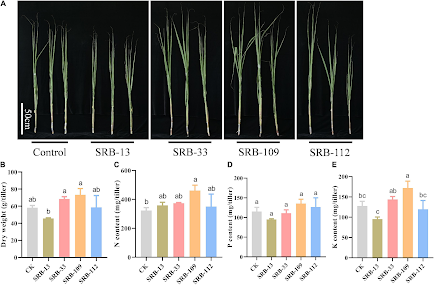By: Kenya Luquin
This image shows the results of the application of beneficial bacterial to soil used to grow sugarcane. Part A) The growth of a sugarcane stem after different bacteria strains were added. Part B) The weight of a sugarcane stem after different bacteria species were added. Part C-E) The content of different nutrients in the soil (nitrogen, phosphate, and potassium, respectively) after different bacteria species were added. Microbial isolate SRB-109 produced the tallest and heaviest stem.
Soil microbes are known to form complex communities with plants. In these interactions, plants provide microbes with nutrients produced from photosynthesis while microbes provide beneficial properties that can improve the plants' overall health. Sugarcane is an important crop worldwide; however, it is a type of crop that requires large amounts of nutrients, especially nitrogen. Nitrogen fertilizers are commonly used in agriculture and are known to negatively affect the environment. Some studies have suggested that sugarcane can get most of its nitrogen from a process called nitrogen fixation. In this process, some soil bacteria have the capability to turn nitrogen gas from the air into a form of nitrogen that can be taken up by plant roots. In this study, Li and colleagues isolated several nitrogen-fixing bacteria from the soil directly around the roots of sugarcane. Several sugarcane seedlings each received a nutrient solution containing a different microbial isolate while the control pots did not receive any type of solution. They were grown in a growth chamber for two weeks and the four seedlings with the most growth, along with the control, were then transplanted to a field where they grew for 120 days. The results of this experiment identified a species of bacteria called Acinetobacter, which was labeled SRB-109 in the experiment, as the most beneficial bacterial strain to the growth of sugarcane. While further testing would be useful, this observation could lead to a decrease in fertilizer use as well as more sustainable agricultural practices.
Original article: Li, M., Liu,
R., Li, Y., Wang, C., Ma, W., Zheng, L., Zhang, K., Fu, X., Li, X., Su, Y.,
Huang, G., Zhong, Y., and Liao, H. (2022) Functional investigation of plant
growth promoting rhizobacterial communities in sugarcane. Frontiers in Microbiology,
12: 783925-783925

No comments:
Post a Comment